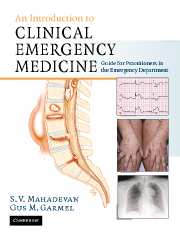13 results
Contributors
-
-
- Book:
- An Introduction to Clinical Emergency Medicine
- Published online:
- 05 May 2012
- Print publication:
- 10 April 2012, pp xi-xvi
-
- Chapter
- Export citation
39 - Expedition Orthopedics
- from PART III - ILLNESS AND INJURIES ON EXPEDITIONS
-
-
- Book:
- Expedition and Wilderness Medicine
- Published online:
- 05 March 2013
- Print publication:
- 03 November 2008, pp 647-672
-
- Chapter
- Export citation
Section 1 - Principles of Emergency Medicine
-
- Book:
- An Introduction to Clinical Emergency Medicine
- Published online:
- 27 October 2009
- Print publication:
- 26 May 2005, pp 1-2
-
- Chapter
- Export citation
Section 2 - Primary Complaints
-
- Book:
- An Introduction to Clinical Emergency Medicine
- Published online:
- 27 October 2009
- Print publication:
- 26 May 2005, pp 143-144
-
- Chapter
- Export citation
Contents
-
- Book:
- An Introduction to Clinical Emergency Medicine
- Published online:
- 27 October 2009
- Print publication:
- 26 May 2005, pp v-x
-
- Chapter
- Export citation
Section 4 - Appendices
-
- Book:
- An Introduction to Clinical Emergency Medicine
- Published online:
- 27 October 2009
- Print publication:
- 26 May 2005, pp 679-680
-
- Chapter
- Export citation
Frontmatter
-
- Book:
- An Introduction to Clinical Emergency Medicine
- Published online:
- 27 October 2009
- Print publication:
- 26 May 2005, pp i-iv
-
- Chapter
- Export citation
List of contributors
-
- Book:
- An Introduction to Clinical Emergency Medicine
- Published online:
- 27 October 2009
- Print publication:
- 26 May 2005, pp xi-xiv
-
- Chapter
- Export citation
Dedication
-
- Book:
- An Introduction to Clinical Emergency Medicine
- Published online:
- 27 October 2009
- Print publication:
- 26 May 2005, pp xix-xix
-
- Chapter
- Export citation

An Introduction to Clinical Emergency Medicine
- Guide for Practitioners in the Emergency Department
-
- Published online:
- 27 October 2009
- Print publication:
- 26 May 2005
Section 3 - Unique Issues in Emergency Medicine
-
- Book:
- An Introduction to Clinical Emergency Medicine
- Published online:
- 27 October 2009
- Print publication:
- 26 May 2005, pp 605-606
-
- Chapter
- Export citation
Acknowledgments
-
- Book:
- An Introduction to Clinical Emergency Medicine
- Published online:
- 27 October 2009
- Print publication:
- 26 May 2005, pp xvii-xviii
-
- Chapter
- Export citation
Index
-
- Book:
- An Introduction to Clinical Emergency Medicine
- Published online:
- 27 October 2009
- Print publication:
- 26 May 2005, pp 753-798
-
- Chapter
- Export citation



